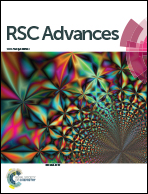Free-standing polyaniline–porous carbon nanofiber electrodes for symmetric and asymmetric supercapacitors
Abstract
Polyaniline (PANI)–porous carbon nanofiber (PCNF) composites were generated by in situ polymerization of aniline on PCNFs for use as flexible, binder-less electrodes for high-performance supercapacitors. The effect of polymerization time on the electrode performance was studied by using symmetric cell configuration. Because of the high faradic current and good charge transfer between PCNFs and PANI, a maximum specific capacitance of 296 F g−1 and excellent rate performance were achieved for PANI–PCNF electrodes. PANI–PCNF electrodes also showed good capacitance retention (98%) after 1000 charge–discharge cycles. Furthermore, an asymmetric cell was successfully fabricated by using PANI–PCNF as the positive electrode and PCNFs as the negative electrode. Energy density and power density were improved significantly by using the asymmetric cell configuration. The resultant PANI–PCNF//PCNF asymmetric supercapacitor exhibited an energy density of 353 W h kg−1 with the power density of 609 W kg−1 at a current density of 1 A g−1.


 Please wait while we load your content...
Please wait while we load your content...